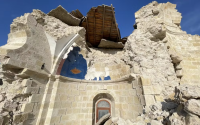24 September 2005 TomPaine.com; Mark Engler
Growing public dissatisfaction; rumblings in Congress against indefinite occupation; expressions of organized resistance. These three factors represent the pillars of opposition to the war in Iraq. Each can fortify the others, and together they could well grow strong enough to force an ignominious U.S. exit from our country's newest imperial outpost.
But while the first two pillars have been holding their weight recently (Bush's approval ratings are at historic lows, and nascent Congressional hearings have been called to discuss potential exit strategies), the peace movement has lately seemed to be missing altogether.
Come this weekend that will change. With large crowds amassing just outside the White House, led by the likes of Cindy Sheehan, George W. Bush will once again have "hit the trifecta."
The peace movement can be credited with good timing in its present mobilization. Still, for many people, its reappearance will seem rather sudden. The large demonstrations will leave many questions unanswered: Where have anti-war organizations been hiding lately? Are they back for good? And what is their contribution likely to be?
What Ever Happened to the Movement?
While generally operating below the radar of mainstream media outlets, organized resistance to the Iraq War has played an important role in laying the groundwork for the present anti-war moment. The apparent absence of a movement in the recent past had a lot to do with strategic decisions made (for better or for worse) by activists and leading peace groups.
During the 2004 election cycle, the great majority of activists decided that beating Bush at the polls should be their priority. Some commentators on the left were highly critical of this strategy, arguing that Kerry's position on the war was hardly better than Bush's. They were right that Kerry's stance on Iraq was far from satisfactory. Yet their argument fell flat in its failure to acknowledge that the removal of Bush from office would have been seen across the world as a firm rebuke of his administration's policies.
More convincing was the critics' contention that, win or lose, a singular focus on the election was a recipe for demobilization after November 2. Following Bush's demoralizing reelection, many people perceive that the peace movement has disappeared into a political black hole. Indeed, since the election, the prevailing sentiment has been that public disapproval of the war has grown to its highest levels yet not because of organized resistance, but in spite of its absence.
But is this really the case? While not altogether unfounded, this feeling overlooks the ways in which peace movement organizations have both tapped into and fed some of the major currents of anti-war sentiment. Counter-recruitment drives, while not widespread, have publicized the worst abuses of aggressive military career salespeople unable to make quota; efforts to highlight the costs of occupation look prescient in light of recent natural disasters; persistent lobbying-in combination with a rising U.S. death toll--has helped to slowly change the tenor of Congressional debate.
Undoubtedly the most significant strategic move on the part of leading organizations like United for Peace and Justice (UFPJ) has been the decision (as Institute for Policy Studies Fellow Phyllis Bennis wrote in a December 2004 strategy paper for the coalition) "to keep organizations like Military Families Speak Out, the new Iraq Veterans Against the War, and others at center stage of our mobilizations." One military family member, in particular, has transformed recent debate about the war.
An Anti-War Rosa Parks?
Following her dramatic stand in August outside President Bush's ranch in Crawford, Texas, Cindy Sheehan has been dubbed "the Rosa Parks of the anti-war movement." The analogy is even truer than the popular mythology around either woman would suggest. While Parks has been memorialized as a solitary seamstress who resisted segregation with a spontaneous act of defiance (refusing to give up her seat on a city bus), she was in fact an experienced activist well-linked to the Civil Rights movement.
Cindy Sheehan's confrontation of President Bush in Crawford also represents a genuine act of personal indignation. But she, too, has not stood alone. Before her rise to national prominence, anti-war organizations like UFPJ and Veterans for Peace created many venues where she could begin to speak out, including protests led by veterans in Fayetteville, NC, home of Fort Bragg, last March. The same month she appeared on the cover of The Nation, with a story entitled "The New Face of Protest?"
Sheehan's Camp Casey was bolstered by the speedy infusion of experienced activists from anti-war groups like Code Pink. Such established networks quickly spread the word about her stand in Crawford, encouraged people to join her, and raised money to help PR efforts. UFPJ organizers are playing a significant role in coordinating the "Bring Them Home Now" bus tour that is carrying her and a group of similarly persuasive anti-war veterans and affected family members to Washington, DC.
The Tipping Point
The same established organizations that lent support to Camp Casey and helped spread its message will provide these speakers with an audience of tens of thousands at this weekend's protests. The mass demonstration comes at a critical time, when many commentators are suggesting that we are on the verge of a "tipping point" against the war.
The incompetent federal response to Hurricane Katrina has created a domestic crisis for the Bush administration to match the debacle in Iraq. The president now faces his lowest approval rating ever, with support hovering around 40% and disapproval of his handling of Iraq jumping to 67%. An AP-Ipsos poll released this week indicates that Bush's speech promising federal funds for rebuilding the Katrina-ravaged Gulf region did not lead to any rebounding of sympathy for him; furthermore, the percentage of Americans who support "immediate withdrawal of some or all of the U.S. troops in Iraq" has jumped 10 points in the past two weeks according to a new Gallup poll, rising to 66%. At the same time, the September 15 ad hoc Congressional hearings on exiting Iraq, led by Rep. Lynn Woolsey, provide the latest signal that an increasing number of lawmakers are starting to get serious about finding a way out.
How do mass protests generate greater anti-war momentum in this context?
Not all of those who come for the demonstration will be calling for the same thing. On the most radical end of the spectrum, the ANSWER coalition will not only demand immediate U.S. withdrawal from Iraq, but will also throw in a long list of additional causes, including an "end to colonial occupation" from Palestine to Haiti. UFPJ will stick with a single, "Bring the Troops Home Now" message. And more moderate supporters of the mobilization, including the Win Without War coalition, will call only for a timetable for U.S. exit.
The disagreements around these demands are real, and the varying positions will affect specific groups' on-going abilities to appeal to segments of the American public. Yet those who shun a march that accommodates a diversity of views overstate the immediate practical importance of these differences. After all, the movement is not setting policy, and none of the demands, from radical to moderate, has much prospect of being promptly adopted. More important than laying out an ideal exit strategy in one's call to action is considering how mass mobilization can promote more urgent discussion of the occupation's failure and urge greater numbers of elected officials to take firm stands against "staying the course."
A Time To Protest
Some critics may complain that large marches and ritualized civil disobedience are stagnant tactics. In some respects they are. Nevertheless, mass demonstrations serve an important function, rallying the movement's base and serving as bellwethers of wider activity.
Those who contend that the energy of mass mobilization could be better directed elsewhere assume that national and local action are mutually exclusive. They fail to take into account how momentum builds on itself. For leading anti-war organizations, national mobilizations translate into an influx of donors and activists. Groups like those that make up UFPJ's coalition leave in a better position to further their work organizing teach-ins and counter-recruitment, prodding action from public officials, and supporting anti-war veterans.
The savviest organizers will always use mass mobilizations to engage participants in local campaigns. In the present case, UFPJ is calling for activists returning home from the demonstration to organize events on October 8 highlighting the "local costs of the war." The coalition is also calling on members of the clergy to conduct religious services against the war on Veteran's Day Weekend in November-a move that local activists can encourage their own religious leaders to follow. Contrary to the "saving our energy" approach, such local actions are simply less likely to happen in periods when national mobilization is low and sympathizers are generally deactivated.
Even when protests themselves are unpopular (Americans are notoriously unenthusiastic about virtually all actions, such as marches, that transgress narrow bounds of electoral-oriented debate), they consistently boost public opinion against the war, opening wider discussion of how our country can exit Iraq.
No doubt, conservatives will try to conjure pictures of flag-burning hippies to make the anti-war movement look like a marginal fringe instead of a legitimate political force. But those who direct their energy to worrying about such backlash rather than organizing to build a better mobilization make two mistakes:
They miss the lesson of John Kerry, who showed that the right-wing machine will do its best to demonize all opposition, and that no amount of tepid moderation will deter them.
And they give too little credit to organizers in groups like UFPJ, Military Families Speak Out, and Iraq Veterans Against the War, who rarely match the stereotypes, who have a sophisticated understanding of tactics (eschewing radical dogmatism, they are combining marching, religious services, lobbying, and direct action in DC), and who are asking for the broadest possible support this weekend.
The more support they get, the more that an increasingly energized movement will help sparks like Cindy Sheehan's Crawford encampment ignite wider swaths of anti-war public opinion. In turn, more Members of Congress will feel heat not just from the national Mall, but also in their home districts. For a peace movement just re-emerging from the shadows, such would be a worthy contribution.
-- Mark Engler, a writer based in New York City, is an analyst with Foreign Policy In Focus. He can be reached via the web site http://www.democracyuprising.com. Research assistance for this article provided by Katie Griffiths. This article was first published on TomPaine.com and appears with permission of the author.
http://www.zmag.org/content/print_article.cfm?itemID=8805§ionID=51






